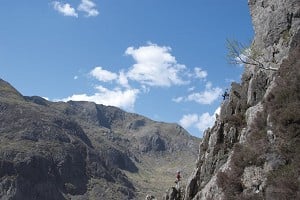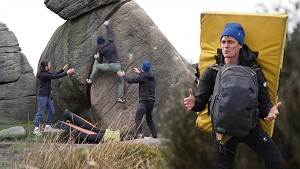
The stunning orange limestone walls of Taghia are known to visitors as having some of the greatest multi-pitch bolted routes anywhere.

The village of Taghia consists of only a few dozen buildings nestled not far from the base of a slew of massive walls, the giant tooth-like Oujdad juts out centrally, flanked by three converging gorges and adjacent walls. The tallest of these stretches up to around 700m, whilst many others are around 600m. The village is at roughly 2000m altitude and by the time you finish a climb you are often coming close to 3000m, where the air seems to have an alpine chill. It may be scorching hot in fine weather, but if a storm kicks up the temperature drops suddenly and the feeling of being in an African desert is replaced by the sting of large hailstones and worryingly close lightning.
Although most of the 'well-known' classic routes lie in the 7a to 7c grade range, there are more than 150 routes in Christian Ravier's 2008 guidebook – with grades from 5 to 8a, including a huge number of more reasonable routes from 6a to 7a.
"...and the feeling of being in an African desert is replaced by the sting of large hailstones and worryingly close lightning..."
Logistics
How to Get There
A short flight from London to Marrakech, then a 6 hour drive to Zaouiat Ahansal (there are about a dozen different ways to spell this - it is pronounced zaa-we-ah), then a 2 hour hike to Taghia.
Flights are available from Easyjet, Ryanair and Royal Air Maroc (also known as Atlas Blue). Having flown with Royal Air Maroc I would recommend Easyjet or Ryanair. We chose Royal Air Maroc because we had a lot of overweight baggage and their price per kilo was more reasonable when we made the booking, unfortunately they changed their pricing after we booked and ended up getting stung for several hundred pounds at check in, being overcharged or cheated out of money became a recurring theme for our stay in Morocco.
For the drive to Zaouiat Ahansal we booked a jeep in advance with the tour company (Assounfou Tours) because we had loads of equipment and wanted to keep it simple. There will probably be cheaper ways to get there, but take care with cowboy taxis! There is a story on climbing.com (see the links section) of a driver attempting to abandon his customers in the middle of nowhere after he realised that his mini-van couldn't handle the roads.
If you have a lot of equipment it may be helpful to hire donkeys for the hike from Zaouiat to Taghia. Youssef Rezki, the owner of the Gite in Zaouiat, will be able to arrange donkey hire. It's worth noting that Taghia is pronounced taa-hia (say the hia as though you're clearing your throat).
When to Go
There are varying reports from teams who have visited Taghia, many have enjoyed almost month long periods of uninterrupted sunshine, others had an occasional storm and others had frequent rain and storms. Most teams visit in April to May or September to October, avoiding the full blown summer. Being at around 2000-2800m altitude, the area remains comparatively cool relative to lower lying places - it may be possible to climb in summer, particularly as there are many routes on north facing walls. We were there in September and had regular storms and heavy rain. The storms were quite predictable and even the north facing walls dried quickly, so plenty of climbing was still possible. However, take note of the risk of flash flooding when in the gorges, in very heavy rain it can be a matter of minutes before narrow sections become impassable, in addition run-off from the plateau can bring down rock fall.
Accommodation Advertise here
No Premier Listings found in this area
There is accommodation in Zaouiat at Youssef's Gite:
Youssef Rezki, Douar Taghia, Zaouiat Ahansal 22010 Azilal Maroc. Tel: 00 212 68909843, aoujdade@yahoo.fr
The closest accommodation to the climbing is in Said's Gite in Taghia:
Saïd Messaoudi, gitesaid@yahoo.fr
Both Gites offer meals. It is recommended that you sterilise all water before drinking – even the 'drinkable' water, severe stomach upsets are commonly reported by visiting climbers. We used a substantial amount of ciprofloxacin to keep our health problems at bay – it may be worthwhile to stock up on this or other antibiotics.
Food
We stocked up on food from an out of town supermarket, but in hindsight, with a bit of effort and hunting around we probably could have saved a lot by haggling in the markets. If you are going to do this, stay away from the main tourist markets around Djemaa el Fna as these are extortionate compared to the 'local' markets. The good markets will take a bit more effort to find but you should be able to get help from your hotel reception or someone else local.
Almost without exception, everyone we had any kind of business with ripped us off or tried to rip us off. Restaurants, cafes, money exchanges, accommodation and transport providers. Often things that we didn't order would be slipped into bills, or extra nights added to accommodation bills, or just mathematical 'errors'. By the time we left we almost felt compelled to count money from ATM machines. Always agree on a reasonable price before accepting any service and double check the sums at the end.
Useful links
Most of the guidebook is available online here, along with additional location maps which prove very useful as the guidebook often doesn't give many clues for finding where the routes start.
There is a useful article about an American team who visited Taghia in 2007 at climbing.com.
Which guidebook do I buy?
There is a French language guidebook for Taghia written by Christian Ravier, published in 2008. The book, in spite of being in French, is still useful for the topos. It can be bought from the author: Christian Ravier, cravier@club-internet.fr
New routes are generally written up in a logbook in the Gites in Taghia.
New route potential
In spite of steadily increasing popularity Taghia retains a massive amount of unclimbed rock. Even in the more established areas (Oujdad, Ta'oujdad and Tagoujimt N'tosouïant) there is often potential to find an attractive line in between existing routes.
The eastern gorge in the Agoudal N'llamchane area is several kilometres long and is home to vast stretches of attractive walls. Walking down the gorge is truly awe inspiring. However access is somewhat more challenging compared to the more established areas. It takes roughly 6 hours to hike with donkeys from Taghia to the East entrance of the gorge, although if you don't have donkeys it may be possible to take a substantial shortcut.
- Expedition report: Raru Valley in the Himalayas 6 Dec, 2011
- Trip Report - Taghia Gorge, Morocco 5 Jul, 2009
- A Carbon Fibre Carabiner - Is It Possible? 22 Jan, 2009




















Comments